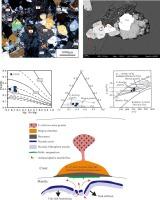Petrogenesis of U-rich two-mica granite from the Mesozoic Reshui pluton (Nanling Range, South China) with implications for uranium mineralization
IF 2.7
3区 地球科学
Q2 GEOSCIENCES, MULTIDISCIPLINARY
引用次数: 0
Abstract
Muscovite-bearing granites are the dominant rock type associated with metallic deposits in South China. Some of these granites are rich in U and considered potential sources for subsequent hydrothermal uranium mineralization. Although widely studied, the petrogenesis of muscovite-bearing granites remains obscure. The Reshui pluton contains fine-grained biotite granite and coarse grained two-mica granite (CGTG). CGTG exhibits high U concentrations (5.07–40.15 ppm, average 15.94 ppm) and is typical of U-rich granite in South China. We conducted detailed petrographic, geochemical and biotite mineralogical analyses of the CGTG from the Reshui pluton. Our findings provide new insights into the petrogenesis of U-rich granites in South China and their significance for uranium mineralization. LA-ICP-MS zircon U–Pb dating shows that the CGTG were formed at 167.3 ± 1.7 Ma. Integrated petrological, whole-rock geochemical and biotite geochemical data, the negative and limited variation of the εNd(t) values (from − 10.8 to − 9.6) and a two-stage Paleoproterozoic model age (1.72 to 1.83 Ga), suggest the U-rich S-type CGTG formed by partial melting of Paleoproterozoic clay-rich pelitic rocks and underwent extensive fractional crystallization. The U-rich pelitic magma sources characterized by relatively low oxygen fugacity and temperature, relatively high degree of magmatic differentiation and F content are the main factors controlling U enrichment in the Reshui pluton CGTG. The petrologic and whole-rock geochemical characteristics, together with the biotite chemical compositions and disseminated U-rich accessory minerals including uraninite, indicate that the CGTG in the Reshui pluton has a high uranium mineralization potential and should be given more attention in further explorations.

中生代雷水岩体(华南南岭)富铀双云母花岗岩的岩石成因及其对铀矿化的影响
含熔岩的花岗岩是华南金属矿床的主要岩石类型。其中一些花岗岩富含铀,被认为是后续热液铀矿化的潜在来源。尽管对含麝香石花岗岩的岩石成因进行了广泛的研究,但其成因仍然模糊不清。丽水岩体包含细粒生物花岗岩和粗粒双云母花岗岩(CGTG)。粗粒双云母花岗岩的铀含量较高(5.07-40.15 ppm,平均 15.94 ppm),是华南地区典型的富铀花岗岩。我们对来自Reshui岩体的CGTG进行了详细的岩石学、地球化学和生物矿物学分析。我们的研究结果为了解华南地区富铀花岗岩的岩石成因及其对铀矿化的意义提供了新的视角。LA-ICP-MS锆石U-Pb年代测定显示,CGTG形成于167.3 ± 1.7 Ma。综合岩石学、全岩地球化学和生物岩石地球化学数据、εNd(t)值的负向有限变化(从-10.8到-9.6)和两段古近纪模型年龄(1.72到1.83 Ga),表明富铀S型CGTG是由古近纪富粘土质球粒岩部分熔融形成,并经历了广泛的分块结晶过程。富含铀的球粒岩岩浆源具有相对较低的氧富集度和温度、相对较高的岩浆分异程度和萤石含量等特征,是控制瑞水岩柱CGTG中铀富集的主要因素。岩石学和全岩地球化学特征,以及生物岩化学成分和包括铀矿石在内的富铀伴生矿物的赋存,都表明了瑞水系块体CGTG具有很高的铀成矿潜力,在进一步勘探中应给予更多的关注。
本文章由计算机程序翻译,如有差异,请以英文原文为准。
求助全文
约1分钟内获得全文
求助全文
来源期刊

Journal of Asian Earth Sciences
地学-地球科学综合
CiteScore
5.90
自引率
10.00%
发文量
324
审稿时长
71 days
期刊介绍:
Journal of Asian Earth Sciences has an open access mirror journal Journal of Asian Earth Sciences: X, sharing the same aims and scope, editorial team, submission system and rigorous peer review.
The Journal of Asian Earth Sciences is an international interdisciplinary journal devoted to all aspects of research related to the solid Earth Sciences of Asia. The Journal publishes high quality, peer-reviewed scientific papers on the regional geology, tectonics, geochemistry and geophysics of Asia. It will be devoted primarily to research papers but short communications relating to new developments of broad interest, reviews and book reviews will also be included. Papers must have international appeal and should present work of more than local significance.
The scope includes deep processes of the Asian continent and its adjacent oceans; seismology and earthquakes; orogeny, magmatism, metamorphism and volcanism; growth, deformation and destruction of the Asian crust; crust-mantle interaction; evolution of life (early life, biostratigraphy, biogeography and mass-extinction); fluids, fluxes and reservoirs of mineral and energy resources; surface processes (weathering, erosion, transport and deposition of sediments) and resulting geomorphology; and the response of the Earth to global climate change as viewed within the Asian continent and surrounding oceans.
 求助内容:
求助内容: 应助结果提醒方式:
应助结果提醒方式:


